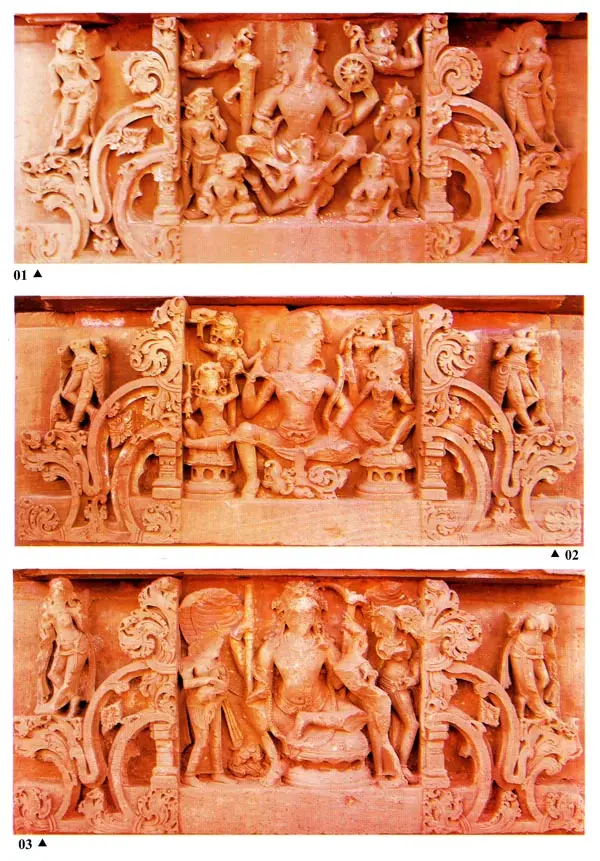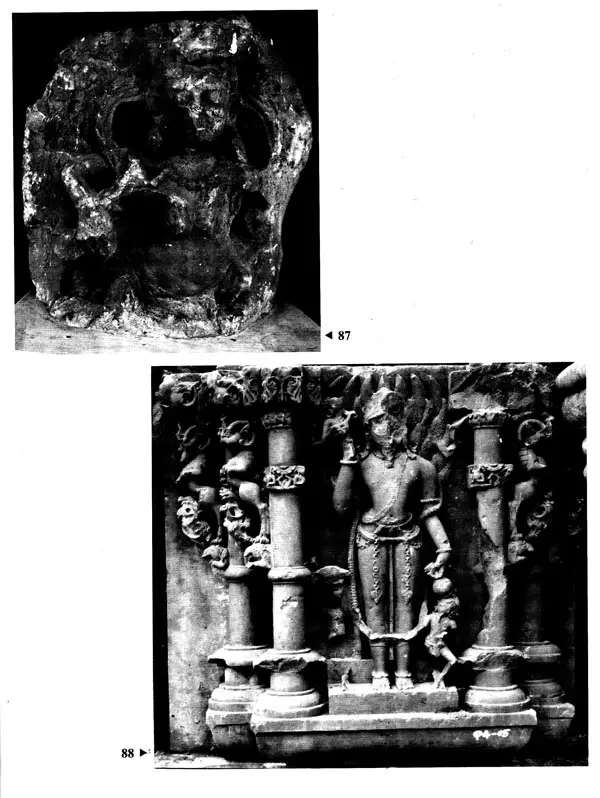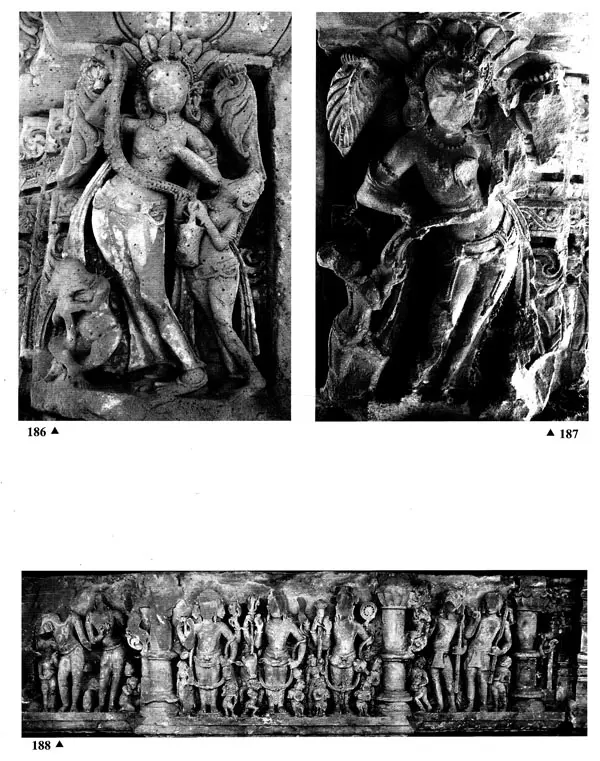
Sculptural Art of Abaneri - A Paradigm
Book Specification
| Item Code: | UAD362 |
| Author: | Rajendra Yadav |
| Publisher: | Jawahar Kala Kendra, Jaipur |
| Language: | English |
| Edition: | 2006 |
| ISBN: | 8181820290 |
| Pages: | 234 (Throughout Color and B/W Illustrations) |
| Cover: | HARDCOVER |
| Other Details | 11.50 X 9.00 inch |
| Weight | 1.04 kg |
Book Description
The scholars have explored the entire state of Rajasthan far and wide and published several monographs on art and architecture and papers on them. The study of Abaneri was started in the beginning a twentieth century with short reporting in the List of object s of Antiquarian Interest in the Sates of Rajputana in 1903. Later and sooner after lapse of two decades B. C. Dharma has reported in the Archaeological Survey of India Annual Reports 1925-26. Subsequently two articles were published in Harp, 1955, by Pupal Jayakar & R.C. Agrawala with details of some of the sculptures. However, the exhaustive work has not been done so far, in respect of sculptures of Abaneri by this time. The art treasure of Abaneri has allured me very much when I was documenting the sculptures and temples of Rajasthan, which are centrally protected. The idea was in low instinct since long time, but crystallized in the mind few months back to prepare a detail illustrated catalogue of sculptures on the most curios art objects of Rajasthan.
Here an attempt is being made in following pages to present the architectural and sculptural treasure of Abaneri at one place as whole. The work is mainly baud on the documentation of Harshatmata temple and its sculptures kept on the site and which are shifted to different museums of the state and National Museum, New Delhi. The approach of work is interpretative and appreciative, hence it is tried to tender the correct identification of the gods and goddesses and other divinities. Since the sculptures are of two categories, i.e. fixed and loose. The loose sculptures have been stored in different am museums viz, Govt. Museum, Amber (89), Govt. Museum, Hawamahal (04), Sawai Man Singh II museum (City Palace, Jaipur 02), Govt. Central Museum, Jaipur (02) and National Museum, New Delhi (01). The sculptural shade of the ASI contains 287 number of documented, 2 undocumented loose sculptures in Chand Baori Store and eighty-two number of sculptures are fixed in the Harshatmata temple while 10 sculptures are fixed in the Chand Baori itself.
This book contains the descriptions of 258 important sculptures which are broadly classified in different groups according to sect and themes. It contains introduction of the site with historical backdrop, architectural details of the temple, art, iconographic forms and catalogue. In addition, the architecture of the temple has been described in detail and it is suitably illustrated with line drawings, plans and photographs to facilitate the scholars and students. Except the mandapa, the location of important fixed sculptures are properly marked in drawings for the convenience of readers. These drawings are well captioned with architectural nomenclature of Sanskrit origin which are generally used in the standard books of temple architecture, would be helpful and caters to the need of the ancients especially.
The catalogue part of the book contains nine points description viz. name of the object, accession number, category, period, location, description and published references. Most of the standard books on catalogue have all these information's in such way. However, at some place readers may feel some ambiguity. So, I feel they need some explanations about few columns. The tide of the sculptures are being opted which are more popular and convincing to the scholars and readers. In the accession column I have used more thin two abbreviations for the site because it was my compulsion to adopt their old abbreviations along with accession numbers, but first three letters such as ASI, HMM, NM, ABM, CMJ, etc. are denoting the name of the respective museums where these objects are housed. In case of the published references some of sculptures me not having any published reference, hence, they are devoid of that column.
As any work of writing is a time taking effort, so, since I have started the work, received various kind of help and support from others. First & foremost I owe my gratitude to Shri Ashok Sekhar, IAS, Principal Secretary, Art and Culture, Govt. of Rajasthan who kindly granted permission to publish this catalogue. I am indebted to Shri Sandeep Verma (IAS), Director, Deptt. of Archaeology & Museums, Govt. of Rajasthan for his valuable suggestions. I am also thankful to Shri K.K Singhal, Dy. Secretary, Art and Culture for his administrative support.
My deep gratitude to Shri Jagat Pati Joshi, Former Director General, Archaeological Survey of India who enlightened me always with his versatile knowledge of archaeology and giving his constant morel supports. I am deeply grateful to all my teachers Shri R.S. Bisht, Former Joint D.G. ASl, Prof. R.C. Agrawal, Joint D.G. ASI, Dr. B.R. Mani, Director, ASI and Dr. L.K. Pandey, Director, Institute of Rajasthan Studies, Udaipur for their constant help and encouragement. I have great privilege to pay my sincere thanks to Shri C. Dorje, Director, ASI and Dr. D.N. Dimri, Superintending Archaeology id the ASI who had provided an opportunity to document the sculptures of Abaneri.
I am thankful to Shri R. C. Agrawala, Former Director, Archaeology and Museums, Govt. of Rajasthan who always provide the valuable suggestions and references for this book. My sincere thanks to Dr. Chandramani Singh, Director (Documentation), Jawahar Kala Kendra for her constant support and rendering help in corrections for finalizing the script. My senior colleagues Shri Kishan Lal Dy. Director (IC); Shri Om Prakash Sharma, Superintendent, Jantar Mantar; Shri Jodha Ram Babur, Superintendent, Excavations; Shri S.P. Srivastava, Superintendent, Documentation; Smt. Shashi Prabha Swami, Chief Chemist, Shri Pankaj Dharendra, Superintendent, Govt. Central Museum, Jaipur; Shri Rakesh Chholak, Curator, Central Museum, Jaipur, Shri Babu Lal Maurya, Custodian Govt. Museum, Amber and all the officers and staffs of the department who have extended his kind support during the compilation of work. Indeed, I am thankful to all of them.
The tiny village named Abaneri having the ruins of ancient Abhanagari is situated on the Jaipur-Agra highway, The site was first reported in the "List a Objects of Antiquarian Interest in the States of Rajputanas" in 1903 and latter by B.C. Dharma in the Annual Report of ASI, 1925-26. Since then it was cleared of the debris by Archaeological Survey of India and conserved it. The group has an impressive complex consisting of Harshatmata temple and a baori. Though at present the temple is having an image of Lakshmi in the sanctum, originally the temple appears to be a Vaishnavite temple as the vedibandha has an image of Aniruddha, Pradyuma and Sankarshana. The deity in the sanctuns was in later times substituted by an image of Durga, named Harshatmata and presently an image of Lakshmi is installed. The clearance for conservation of the temple has brought to light that it was a sandharaprasda type of temple enclosed by subsidiary shrines belonging to the early phase of Pratihara period (circa 8th-9th century AD). The temple has been decorated with some of the finest pieces of early Pratihara art of the area. During the ruinous stage of this temple complex its stray sculptures have been collected by various agencies. The loose sculpture are available at various places in display or in their reserve collections. There are about 258 sculptures which are kept in Govt. Museum, Amber, Govt. Museum, Hawamahal, City Palace, Jaipur, Govt. Central Museum, Jaipur, National Museum, New Delhi and in the Archaeological Survey of India.
Few of these sculptures are studied and published earlier e.g. by Pupul Jayakar, R.C. Agrawala, C. Margabandhu and Michael Meister and M.N. Dhaky but for any art appreciation of the site and its antiquities, it is necessary to have a comprehensive catalogue of the presentable sculptures. To achieve this aspect, Shri Yadav's attempt is laudable. For the first time he has taken pains to catalogue the art wealth of Abaneri in a systematic way. These include 258 presentable sculptures and architectural pieces out of 479. Besides, this the book also contains chapters on Architecture, Art, Iconography, Catalogue, Concordance and a Glossary. These chapters have added to the academic contents of the work. The catalogue entries are in very informative format with published references also wherever available. Such catalogues are of considerable value both for scholars and students. The art of Abaneri besides the aesthetic appeal has appreciably reflected the dress, ornaments and furniture of the early Pratihara period which has been also dealt with. In the depiction it echoes the well established tradition of linear rhythm of the Gupta. The delicacy of figures and their expressions could be perceived and enjoyed by an art lover in theses sculptures.
I congratulate the author for bringing out a very useful catalogue which I hope will be welcomed both by the students and serious scholars of art history.













